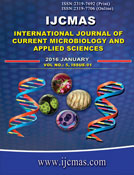


 National Academy of Agricultural Sciences (NAAS)
National Academy of Agricultural Sciences (NAAS)

|
PRINT ISSN : 2319-7692
Online ISSN : 2319-7706 Issues : 12 per year Publisher : Excellent Publishers Email : editorijcmas@gmail.com / submit@ijcmas.com Editor-in-chief: Dr.M.Prakash Index Copernicus ICV 2018: 95.39 NAAS RATING 2020: 5.38 |
Urinary tract infections are common, easily diagnosed conditions with established laboratory methods of evaluation. Escherichia coli is by far the most common pathogen, accounting for about 80% of culture positive urinary tract infections. This study was undertaken to know the prevalence and antibiogram of uropathogens in our hospital. A total of 2191 clean catch midstream urine samples were processed in clinical microbiology laboratory during the study period. Uropathogens were identified by standard techniques and antibiotic sensitivity testing was carried out by Kirby Bauer Disk Diffusion method as per CLSI guidelines. Male to female ratio was 1:1.06. Escherichia coli was the predominant isolate accounting for 57.14% followed by Klebsiella species (17.62%), Enterococcus species (8.1%), Pseudomonas aeruginosa (6.98%), Staphylococcus species (3.97%). 64.44% of E.coli and 53.15% of Klebsiella produced ESBL. E.coli was highly sensitive to Amikacin (89.17%) and Nitrofurantoin (85.83%). Our study showed a high prevalence of UTI in females and in the elderly patients. Most of the gram negative bacilli showed increasing rates of resistance Cephalosporins, Fluoroquinolones and Trimethoprim-sulfamethoxazole. The resistance pattern is on the rise indicating the need to establish antibiotic policies and take stringent measures to ensure effectiveness of the same.
 |
 |
 |
 |
 |